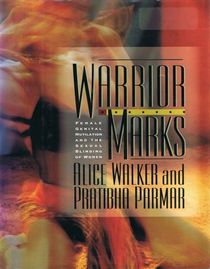
Last week, I attended an undergraduate class on feminist documentary in lieu of attending Visual Research Methods. During class, we watched a film called Warrior Marks in which Alice Walker and Pratibha Parmar explore the meaning, origin, traditions, and consequences of female genital mutilation (FGM). In the documentary, Walker and Parmar argue that although excision and infibulation are most often performed by women, FGM is patriarchy’s attempt to control female sexuality and to keep them in a child-like state. Through interviews with the women who perform FGM, women who encourage FGM for their own children, victims of FGM, and those who have escaped the practice, Walker and Parmar show the war that is positioned against women. However, they do not argue for victimizing those who suffer FGM. Rather, they posit the wounds as warrior marks. Walker and Parmer argue that women can draw on their strength and fight back, even after they have been subjected to FGM.
While I wholeheartedly stand behind these ideas, I am less sure about Alice Walker’s comparison of her own eye injury to the injuries of those who have undergone FGM. When Walker was a child, her parents gave her brothers guns. One of her brothers aimed at Walker and hit her in the eye. To Walker, it was apparent that the injury was purposeful, but despite its severity, her parents quickly ignored it. She calls her eye injury a patriarchal wound. Like FGM, she argues, her visual mutilation is a result of inequalities. Walker states that everyone else “is making merry” and leaves those with patriarchal wounds (FGM or otherwise) to heal and cry in isolation. I agree that Walker’s eye injury is a patriarchal wound, so to speak. It was purposefully inflicted on her by an older, larger brother by a gun that was given only to her male siblings because such a toy was not appropriate for girls. However, I don’t think Alice Walker can fully relate to the women and girls who endure FGM for a few reasons.
- Walker’s eye injury is not an injury systematically inflicted on most girls in order to suppress their womanhood and maintain their oppression.
- Even though her blindness remains, Walker had the ability later in life to remove the scar tissue on her eye and restore a normal appearance. She does not have to endure daily physical pain like that associated with FGM.
- Her injury has not taken away her sexual functioning, nor has her ability to be an autonomous sexual being been mutilated
- Although she had a poor childhood, she had the privilege of attending college and making her way into a position of power as a widely recognized feminist activist in the United States. The girls and women who undergo FGM are not in this position. They differ in education and class and may not have the opportunity, as Walker has, to have their voices heard and their patriarchal wounds recognized.
I’m not trying to say that Alice Walker’s injury is insignificant and that the parallels she draws between her own injury and those who are subjected to FGM are unwarranted. Rather, I’m trying to point out the issues that Walker seems to miss in her documentary. Poetically, it makes perfect sense to equate her patriarchal injury with that of those who suffer FGM. However, I think it is important to recognize the differences in intent and consequences of both injuries as well as the differences in education and class position of the injured women.